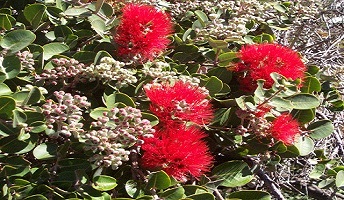Last updated: March 10, 2018
Lesson Plan
A Habitat Is A Home

- Grade Level:
- Lower Elementary: Pre-Kindergarten through Second Grade
- Subject:
- Science
- Lesson Duration:
- 60 Minutes
- State Standards:
- Hawai‘i Content and Performance Standards III
SC.K.1.1, SC.K.1.2, SC.1.3.1, SC.1.5.2, SC.2.3.1, SC.2.5.1 - Additional Standards:
- Next Generation Science Standards
K-ESS3-1, K-LS1-1, 2-LS4-1, - Thinking Skills:
- Applying: Apply an abstract idea in a concrete situation to solve a problem or relate it to a prior experience. Creating: Bring together parts (elements, compounds) of knowledge to form a whole and build relationships for NEW situations.
Objective
At the end of this lesson, the students will be able to demonstrate an understanding that a habitat is a home, and native habitats are the best and only home for native species.
Background
From their leafy branches to their tangled roots, trees provide a habitat for a host of plants and animals. In this activity, children will inventory the plants and animals that live in, on, and around trees and discover how plants and animals depend on trees in many ways. The tree does not have to be alive. Even dead trees, or snags, can provide a habitat for a number of different species.
Students will use the worksheet, magnifying glasses (optional) and their observational powers to notice what creatures make a tree their habitat.
Preparation
None.
Materials
A Tree is a Home Worksheet
Download A Tree is a Home Worksheet
Lesson Hook/Preview
Students apply knowledge of ecosystems found outside.
Procedure
Step 1: Introduction
- Review the concept of habitat with the children.
- Brainstorm different animals and what their habitat is.
- Humans have the same basic needs for survival as other living things. When we need food, we go to the local shopping center.
- When a forest creature needs food it doesn't need to look very far at all. In the forest the living things survive by finding all they need to eat and drink in the place where they live.
- The forest plants make their own food using sunlight, water and soils.
- Many small animals and insects eat the leaves of the tree they live on. They also eat the flowers, fruit and seeds that the tree may produce. These parts of the tree are delicious food for birds, and insect larvae.
- But these little creatures need to be very careful because if it is dinner time for them, it might be dinner time for other animals nearby. These other animals are always in the mood for a feast of bugs, insects or small creatures.
- Explain how many creatures can depend on a single tree for their survival
Step 2: A Tree is a Home Worksheet
Hand out the "A Tree is a Home" worksheet. Have students bring their worksheet, a pencil, and clipboard if available or a hard book or folder to support their activity sheet. Also bring along magnifying glasses if they are available.
- Tell the students they will go outside and study what species are found on a tree.
- They will search up close at the leaves, the trunk, the base of the tree, and the branches to see what type of habitat it provides.
- Pick a tree to observe.
- Have the students draw what they see on the A Tree is a Home student activity sheet. The tree doesn't have to be alive. Even dead trees, or snags, provide habitats for a number of different species.
Step 3: Conclusion
After coming back inside, ask them:
- What are some of the plants and animals that depend on trees?
- What do trees provide for these plants and animals?
- Can you see signs of life on the trunk, branches, roots, and leaves?
- How is the tree affected by the plants and animals that live on it? (they may benefit, harm, or be neutral to the tree)
Vocabulary
Habitat: A home where an animal or plant finds food, water, shelter and space to survive.
Species: A plant, animal, or insect.
